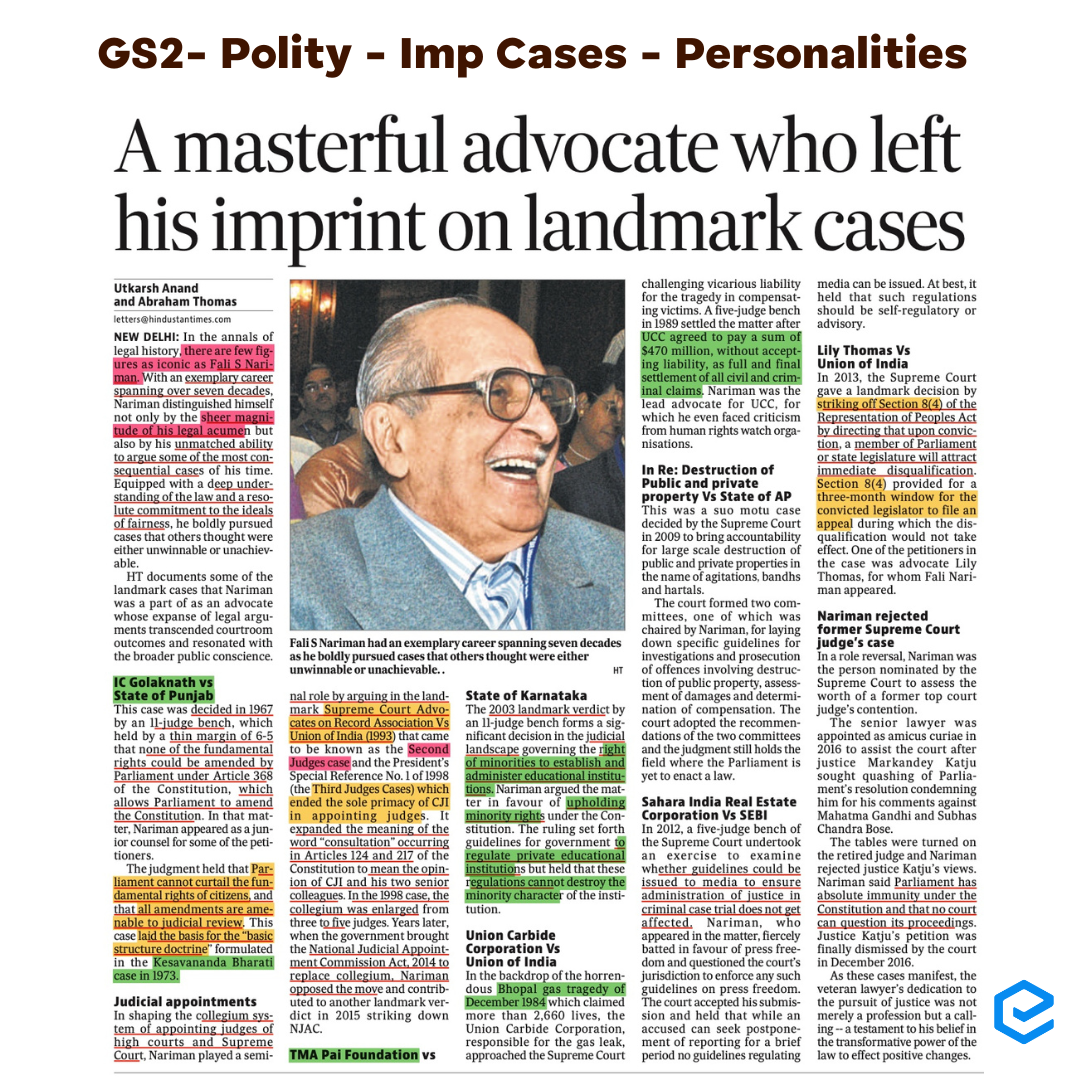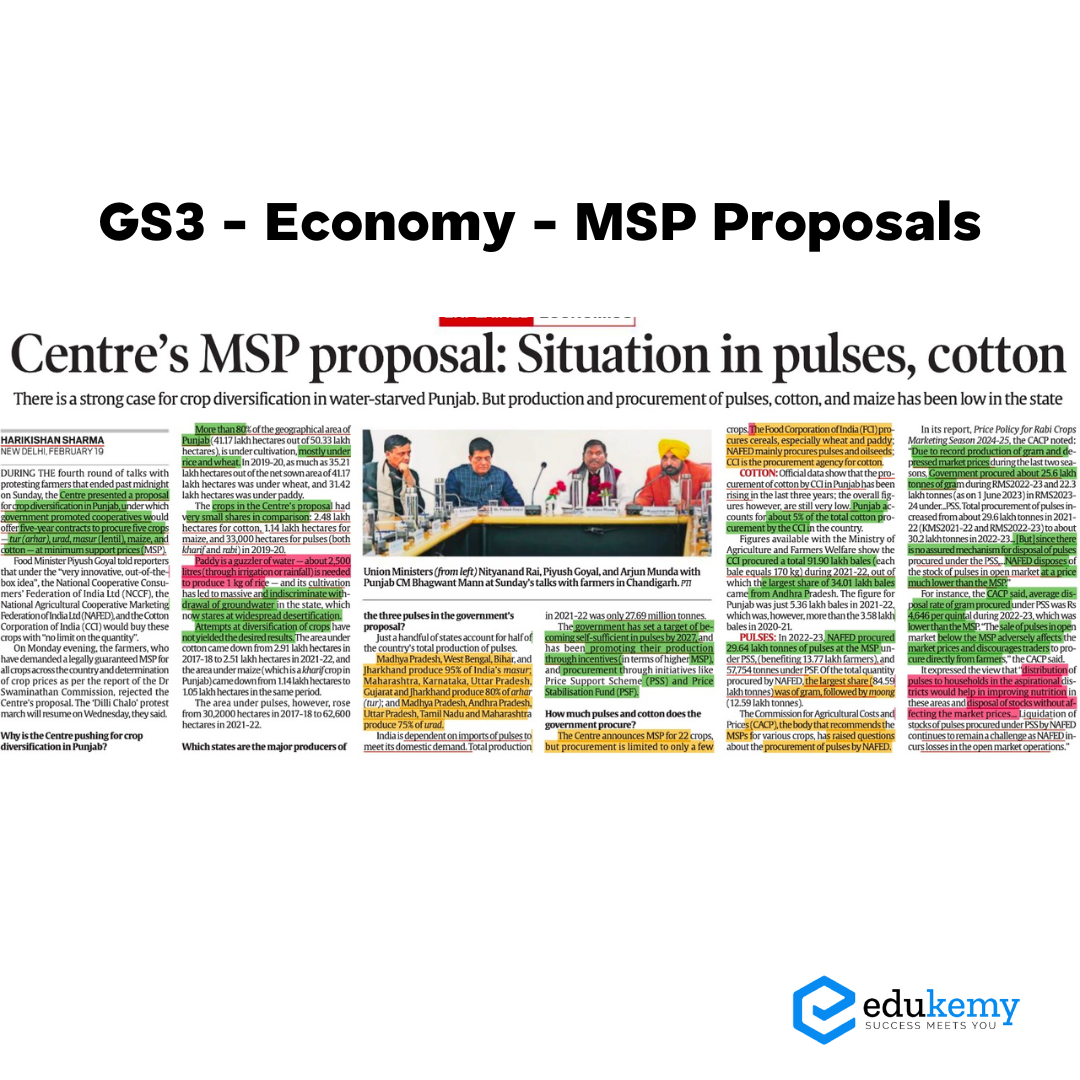Saturday, 24th February 2024
Maratha Reservation Bill
In News: The Maharashtra Assembly approved the Maharashtra State Reservation for Socially and Educationally Backward Classes Bill 2024, allocating 10% reservation for the Maratha community in jobs and education.
Highlights of the Maratha Reservation Bill
- Background of the Bill
- Based on the Maharashtra State Backward Class Commission's report, the Maharashtra State Reservation for Socially and Educationally Backward Classes Bill 2024 has been introduced.
- The Bill identifies the Maratha community as socially and educationally backward, justifying the need for reservation.
- Legal Framework and Reservation Provisions
- The Bill specifies the Maratha community as a Socially and Educationally Backward Class under Article 342A (3) of the Indian Constitution.
- Provides reservation for Marathas under Articles 15(4), 15(5), and 16(4) of the Constitution.
- Creamy layer principle is applicable, limiting reservation to non-creamy layer Marathas.
- Empowered Constitutional Articles
- Article 342A (3): Allows states to prepare and maintain a list of socially and educationally backward classes.
- Article 15(4): Empowers the state to make special provisions for the advancement of SEBCs, SCs, and STs.
- Article 15(5): Enables the state to reserve seats in educational institutions for backward classes.
- Article 16(4): Authorizes the state to reserve appointments or posts for any backward class.
- Reservation Percentage and Legal Challenges
- The Bill justifies reservations for Marathas above the 50% ceiling, citing "exceptional circumstances and extraordinary situations."
- With the additional 10% reservation for Marathas, Maharashtra's total reservation reaches 62%.
- Arguments For and Against
- Arguments in Favor:
- Addressing socio-economic backwardness among Marathas.
- Enhancing representation in government jobs and education.
- Arguments Against:
- Doubts about the legal viability given past legal challenges.
- Controversy over recognizing extended relatives under the Kunbi Certificate.
- Arguments in Favor:
Way Forward
- Ensure legal soundness with robust empirical data.
- Adopt integrated policies combining reservation with holistic development initiatives.
- Prioritize sustainable development addressing root causes of backwardness.
- Promote social cohesion through understanding and support for affirmative action.
Background of Maratha Reservation
- Narayan Rane Committee (2014): Recommended 16% reservation, later stayed by the Bombay High Court.
- Gaikwad Commission (2018): Enacted SEBC Act with 16% reservation, reduced to 12% and 13% by the Bombay High Court.
- Supreme Court (May 2021): Struck down the quota, citing insufficient data.
- Maharashtra State Backward Class Commission (2023): Recommends separate reservations based on socio-economic factors.
|
UPSC Previous Year Questions Mains (2018) Q. Whether the National Commission for Scheduled Castes (NCSC) can enforce the implementation of constitutional reservation for the Scheduled Castes in the religious minority institutions? Examine. |
Source: IE
SC's Use of Article 142 in Chandigarh Mayoral Election
In News: The Chandigarh mayoral election has recently become a focal point, with the Supreme Court of India utilizing Article 142 of the Constitution to annul the election outcomes.
Supreme Court's Invocation of Article 142
- Objective of Justice in Chandigarh Mayoral Election
- The Supreme Court utilized Article 142 to rectify irregularities in the Chandigarh mayoral election.
- Irregularities stemmed from the presiding officer's illegal conduct, leading to an incorrect declaration of the winner.
Understanding Article 142 of the Indian Constitution
- Empowering the Apex Court
- Article 142 grants the Supreme Court the authority to issue any decree or order necessary for complete justice.
- These orders hold enforceability throughout India, serving as vital tools for judicial intervention.
- Transcending Legal Boundaries
- Allows the Supreme Court to surpass existing laws to ensure justice.
- Empowers the Court to take on executive and legislative roles when deemed essential.
- Supported by provisions like Article 32, Article 141, and Article 136, collectively known as "judicial activism."
- Intervening in Public Interest Matters
- Authorizes the Supreme Court to intervene in cases of public interest, human rights, constitutional values, or fundamental rights.
- Reinforces the Court's role as a constitutional guardian against violations.
Judgments Clarifying Powers under Article 142
- Union Carbide Corporation vs Union of India (1991)
- Ordered compensation for Bhopal gas tragedy victims, highlighting the extensive scope of Article 142(1).
- Clarified that these powers are of a different quality, not subject to statutory prohibitions.
- Supreme Court Bar Association vs Union of India (1998)
- Emphasized supplementary nature of Article 142 powers, cautioning against overriding substantive laws.
- Stated powers are curative and should not undermine litigants' rights or bypass statutory provisions.
- Jideranath vs Jubilee Hills Co-op House Building Society (2006)
- Emphasized avoiding injustice to non-parties while exercising power under Article 142.
- State of Karnataka vs Umadevi (2006)
- Clarified "complete justice" means justice according to law, not sympathy.
- Asserted the court won't grant relief perpetuating illegality encroaching legislative domain.
Criticism of Article 142
- Risk of Encroaching Separation of Powers
- Potential for judicial activism criticisms due to perceived encroachment upon separation of powers.
- Critics argue it grants broad powers without sufficient accountability, risking judicial overreach.
- Potential for Disputes Over Authority
- Concerns about disputes over the Court's authority and interference with legislative or executive domains.
- Article 142's extensive powers are reserved for exceptional cases where existing laws fall short.
|
UPSC Previous Year Questions Prelims (2019) Q. With reference to the Constitution of India, prohibitions or limitations or provisions contained in ordinary laws cannot act as prohibitions or limitations on the constitutional powers under Article 142. It could mean which one of the following? (a) The decisions taken by the Election Commission of India while discharging its duties cannot be challenged in any court of law. (b) The Supreme Court of India is not constrained in the exercise of its powers by laws made by the Parliament. (c) In the event of grave financial crisis in the country, the President of India can declare Financial Emergency without the counsel from the Cabinet. (d) State Legislatures cannot make laws on certain matters without the concurrence of Union Legislature. Ans: (b) |
Source: IE
CERN scientists carry out laser cooling of Positronium
In News: A significant scientific milestone has been achieved as an international research team successfully showcased the laser cooling of Positronium for the first time.
CERN: Unveiling the World of Particle Physics
- Introduction
- CERN, or the European Council for Nuclear Research, traces its roots to the French acronym "Conseil Européen pour la Recherche Nucléaire."
- Established in 1954, CERN is a premier institution dedicated to advancing fundamental physics research globally.
- Mission and Operation
- Founding Mandate: Founded to create a leading physics research organization in Europe.
- Scientific Focus: CERN operates the world's largest particle physics laboratory, delving into the fundamental structure of the universe.
- Instrumentation: Utilizes colossal and intricate scientific instruments to explore the basic constituents of matter—fundamental particles.
- Particle Collisions: Particles are accelerated and made to collide at nearly the speed of light, offering insights into particle interactions and the laws of nature.
- Location and Membership
- Geographical Position: Situated on the Franco-Swiss border near Geneva, Switzerland.
- Membership: CERN currently boasts 22 member states, with India assuming the role of an Associate Member State in 2016 and an Observer in 2004.
Antihydrogen Experiment (AEgIS): Decoding Gravity's Impact on Antimatter**
- Overview
- Objective: AEgIS is a collaborative experiment between European and Indian physicists at CERN, aiming to measure Earth's gravitational impact on antihydrogen.
- Antihydrogen Composition: An antimatter counterpart to hydrogen, antihydrogen comprises a negatively charged antiproton and a positively charged positron.
- Matter-Antimatter Asymmetry: The experiment seeks to explain the observed imbalance between matter and antimatter in the universe.
- Location and Achievements
- Facility: Housed at CERN's Antiproton Decelerator facility.
- Milestone: In 2018, AEgIS achieved a groundbreaking feat by demonstrating the pulsed production of antihydrogen atoms.
Laser Cooling of Positronium: Revolutionizing Particle Physics
- Breakthrough Achievement
- Significance: An international team from AEgIS accomplishes laser cooling of Positronium for the first time.
- Temperature Reduction: Positronium atoms cooled from 380 Kelvin to 170 Kelvin using specialized laser systems.
- Scientific Implications
- Quantum Electrodynamics (QED): Enables spectroscopic comparisons crucial for the study of light and its interaction with charged matter.
- Gravitational Behavior: Facilitates high-precision measurements of matter-antimatter system properties and gravitational effects, unraveling potential new physics.
- Bose–Einstein Condensate (BEC): Opens avenues for creating a positronium BEC, offering insights into coherent gamma-ray light production through matter-antimatter annihilation.
- Potential Applications
- QED Advancements: Enhances our understanding of Quantum Electrodynamics and charged matter interactions.
- Gamma-ray Light Generation: Enables the production of coherent gamma-ray light through positronium annihilation, comparable to laser light with constant phase differences.
Source: IE
Government Allows Donor Egg & Sperm in Surrogacy
In News: The Surrogacy (Regulation) Rules for 2022 have been modified by the Central government to permit the utilization of a donor gamete, encompassing both ova or egg cells and sperm.
Understanding Surrogacy
- Definition
- A surrogate, also known as a gestational carrier, is a woman who conceives, carries, and gives birth to a child on behalf of another person or couple, known as the intended parent/s. The arrangement involves the surrogate agreeing to relinquish the child to the intended parent/s after birth.
- Types of Surrogacies
- Commercial Surrogacy
- Involves surrogacy for monetary benefit exceeding basic medical expenses.
- Altruistic Surrogacy
- No monetary compensation to the surrogate, limited to medical expenses and insurance coverage.
- Surrogacy in India
- Surrogacy practices date back to 1978 in India, gaining recognition as a hub for reproductive tourism and fertility treatments.
- Commercial Surrogacy
- In 2021, the Surrogacy (Regulation) Act, 2021 was enacted to regulate surrogacy practices.
Key Provisions of the Surrogacy (Regulation) Act, 2021
- Regulation of Surrogacy
- Prohibits commercial surrogacy, allowing only altruistic surrogacy.
- Permitted for intending couples facing proven infertility, without commercial motives, and not for exploitation purposes.
- Eligibility Criteria for Surrogate Mother
- Must be a close relative of the intending couple, aged 25 to 35, ever-married with a child, and medically and psychologically fit.
- Cannot provide her own gametes for surrogacy.
- Registration of Surrogacy Clinics
- Clinics require registration by the appropriate authority to undertake surrogacy procedures.
- National and State Surrogacy Boards
- Central and state boards established to oversee surrogacy regulations.
- Offences & Penalties
- Defines offences such as commercial surrogacy, exploitation of surrogate mothers, and abandonment of surrogate children.
- Penalties include imprisonment up to 10 years and fines up to 10 lakh rupees.
Recent Modifications in Surrogacy Rules
- Use of Donor Gametes
- Married couples undergoing surrogacy can use donor gametes, a modification providing relief for those with medical complications.
- Couple's own gametes must be used unless certified by a District Magistrate Board for medical conditions.
- Only one partner (either husband or wife) can use a donor gamete.
- A child born through surrogacy must have at least one gamete from the intending parents.
- Background
- The modification followed Supreme Court doubts about the correctness of existing rules.
- Applications were filed by married women facing conception challenges due to medical complications.
Source: TOI
Initiative on Public Health of Tribal Students
In News: The Ministry of Ayush, with the Ministry of Tribal Affairs and ICMR-NIRTH Jabalpur, initiated a project for Ayurvedic health interventions benefiting 20,000 tribal students.
Health Initiative for Eklavya Model Residential Schools (EMRS): A Holistic Approach
- Scope of the Initiative
- The collaborative effort aims to address the health needs of students aged 10-18 in 55 identified Eklavya Model Residential Schools (EMRS) located across 14 states, particularly in tribal regions.
- Target Areas
- The focus of the initiative revolves around addressing key health concerns such as malnutrition, anaemia, sickle cell diseases, hemoglobinopathies, and tuberculosis through the implementation of Ayurvedic interventions.
- Holistic Health Approach
- The initiative emphasizes the adoption of Ayurvedic principles to instil healthy lifestyle practices among children. This comprehensive approach aims to enhance their overall health, well-being, and disease prevention.
- Integrated Disease Management
- In addition to preventive measures, the initiative adopts an integrated approach to disease management.
- By incorporating Ayurvedic practices, it seeks to provide holistic care and contribute to the overall health improvement of the students.
- Background on Eklavya Model Residential Schools (EMRSs)
- EMRSs play a crucial role in providing quality education to Scheduled Tribes (ST) children in remote areas.
- Beyond academics, these schools focus on holistic development, including sports, skill training, and healthcare.
- This holistic approach aims to facilitate access to higher education and employment opportunities for students from tribal communities.
Source: PIB
Umbrella Scheme on “Safety of Women”
In News: The Union Cabinet has given its approval to the Ministry of Home Affairs (MHA) proposal, allowing the continuation of the 'Safety of Women' Umbrella Scheme from 2021-22 to 2025-26.
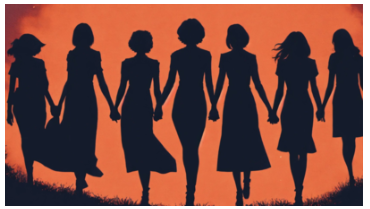
Funding and Proposed Projects for Women's Safety
- The Ministry of Home Affairs (MHA) will finance part of the overall project cost.
- The remaining funding will come from the Nirbhaya Fund.
Continuation of Safety Projects
The Government of India proposes to continue several projects under the "Safety of Women" Umbrella Scheme, including:
- 112 Emergency Response Support System (ERSS) 2.0
- Upgradation of Central Forensic Sciences Laboratories
- Involves setting up a National Forensic Data Centre.
- Strengthening DNA Analysis and Cyber Forensic Capacities
- Focus on State Forensic Science Laboratories (FSLs).
- Cyber Crime Prevention Against Women and Children
- Capacity Building and Training
- Specifically for investigators and prosecutors handling sexual assault cases against women and children.
- Women Help Desk & Anti-human Trafficking Units
Crime Against Women Statistics
According to the National Crime Records Bureau (NCRB) data:
- Crime rate against women per one-lakh population: 66.4
- Chargesheeting rate in such cases: 75.8.
Source: PIB
Tupolev Tu-160M
In News: The Russian President recently revealed the modernized Tupolev Tu-160M, a strategic bomber capable of carrying nuclear weapons, at the Kazan Aviation Plant.

The Tupolev Tu-160M, a modernized version of a Cold War-era bomber, served the former Soviet Union for long-distance weapons delivery in nuclear war scenarios. Here are key details about this Russian supersonic bomber:
- Designation and Nicknames
- Officially known as Tupolev Tu-160M.
- Commonly referred to as the "White Swan” in Russia.
- NATO code-named it “Blackjacks.”
- Performance and Capabilities
- Claimed as the world’s fastest-flying supersonic and heaviest payload-carrying bomber by Russia.
- Designed for precision strikes on targets in remote areas using both nuclear and conventional weapons.
- Capable of flying 12,000 km (7,500 miles) without refueling.
- Crew and Armament
- Operated by a crew of four members.
- Can carry either 12 cruise missiles or 12 short-range nuclear missiles.
- Power and Speed
- Powered by four afterburning turbofan engines.
- Achieves a maximum speed of 2,220 kilometers per hour.
- Can ascend to heights of 16,000 meters.
- Advanced Features
- Equipped with an innovative navigation system.
- Features an upgraded radar system.
- Includes a refueling probe for in-flight refueling, extending its operational range.
Source: HT
Badami Chalukya
In News: Two temples from the Badami Chalukya period, dating back at least 1,300-1,500 years, along with a label inscription that is 1,200 years old, were recently unearthed in Mudimanikyam village along the banks of the Krishna River.
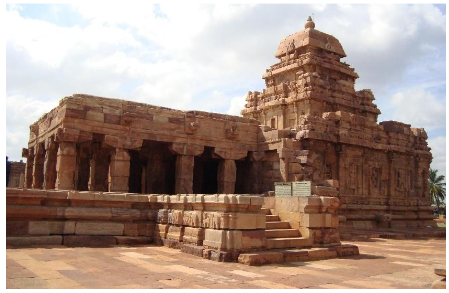
Key Facts about Badami Chalukyas
- Origin
- Pulakesi I founded the Chalukya dynasty in 550.
- Vatapi (Badami) became their capital under Pulakesi I's rule.
- Pulakesi I and descendants are known as the Chalukyas of Badami.
- Their empire covered Karnataka and most of Andhra Pradesh.
- Expansion and Achievements
- Pulakesi II expanded the empire northward and defeated Harsha on the Narmada River.
- He defeated the Vishnukundins in the southeastern Deccan.
- Vikramaditya I restored order, pushing the Pallavas out of Badami.
- Vikramaditya II reached the empire's zenith, capturing Kanchipuram.
- Decline and Overthrow
- Internal feuds led to a decline after Pulakesi II.
- Vikramaditya II restored order, but the dynasty fell to Rashtrakutas in 753.
- Territory and Rule
- Ruled from Kaveri to Narmada at their peak.
- Introduced Vesara architecture, blending South and North Indian styles.
- Notable monuments include UNESCO-listed rock-cut temples at Pattadakal.
- Military and Governance
- Military included infantry, cavalry, elephant corps, and a powerful navy.
- Local governance included Maharashtrakas, Rashtrakas, Vishaya, and Bhoga.
- Autonomous regions ruled by Alupas, Gangas, Banas, and Sendrakas.
- Economy and Administration
- Taxes like Herjunka, Kirukula, Bilkode, and Pannaya were levied.
- Divided into provinces, Rashtrakas, districts, and groups of villages.
- Local assemblies and mahajanas (learned Brahmins) managed affairs.
- Coinage
- Minted distinctive coins with Nagari and Kannada legends.
- Featured symbols like temples, lion or boar facing right, and the lotus.
- Religion
- Initially followed Vedic Hinduism.
- Later inclined towards Shaivism from Vikramaditya I's time.
- Encouraged Jainism, evident in Badami cave temples and Aihole Jain temples.
Source: TOI
Exercise Dosti
In News: Coast guard vessels from India and Sri Lanka recently arrived in the Maldives to participate in the trilateral coast guard exercise, Dosti 16.

Exercise Dosti: Trilateral Coast Guard Collaboration
- Overview
- Trilateral coast guard exercise involving India, Sri Lanka, and the Maldives.
- Conducted biennially.
- Commenced in 1991 between Indian and Maldives Coast Guards; Sri Lanka joined in 2012.
- Focus Areas
- Exercises and drills addressing sea accidents, pollution elimination, and coast guard procedures.
- Emphasis on handling situations like oil spills.
- Objectives
- Strengthen friendship and mutual operational capability.
- Enhance interoperability and cooperation among Coast Guards.
- Dosti 16
- 16th edition of the exercise.
- Participation of Coast Guards from the Maldives, India, and Sri Lanka, with observers from Bangladesh.
- Indian participation includes ICGS Samarth (with integral helo), ICGS Abhinav, and ICG Dornier.
- Purpose
- Build collaboration and cooperation among the participating Coast Guard forces.
Source: ETV
Cantor's Giant Softshell Turtle
In News: Conservationists from the University of Portsmouth recently discovered the nesting site of the elusive Cantor's giant softshell turtle on the Chandragiri River banks in Kerala.

Cantor's Giant Softshell Turtle: A Rare Species
- Names: Also known as the Asian giant softshell turtle and the frog-faced softshell turtle.
- Behavior: Known for its rarity and secretive nature, it spends most of its life buried in the sand, surfacing only twice a day to breathe and capture prey using a sit-and-wait strategy.
- Diet: Primarily carnivores (piscivores), feeding on fish, crustaceans, and mollusks.
- Distribution: Found in eastern and southern India, Bangladesh, Burma, Thailand, Malaysia, Laos, Cambodia, Vietnam, eastern and southern China.
- Habitat: Inhabits inland, slow-moving, freshwater rivers, lakes, streams, and estuaries.
- Conservation Status
- IUCN: Critically endangered.
- CITES: Appendix II.
- Wildlife Protection Act, 1972: Schedule I.
- Threats: Faces habitat destruction and heavy harvesting by locals for meat, leading to its disappearance from many areas.
Source: PO
Overhauling Defence Recruitment
In News: A recent article emphasizes the need to evaluate the challenges associated with the implementation of the Agnipath Scheme and suggests reforms to tackle them.
Concerns Regarding the Agnipath Scheme
- Adverse Effect on Professional Capabilities
- High turnover of young soldiers may impact training capacities and infrastructure.
- Potential augmentation of administrative setup for recruitment, release, and retention challenges.
- Degradation of Operational Capability
- The scheme might worsen the teeth-to-tail ratio (T3R), affecting operational efficiency.
- Specialized roles in the Air Force and Navy may demand technical skills and extensive training.
- Class-Based Recruitment Replaced with All-India All-Class Recruitment
- Shift poses challenges to organizational management, leadership structures, and operating philosophy.
- Soldiers draw motivation from social identity; a shift might impact camaraderie.
- Fomenting Trust and Cooperation Deficit
- Challenges in training, integrating, and deploying soldiers with varied experience and motivations.
- Identifying 25% short-term contracted soldiers may lead to unhealthy competition.
- Doing Away With State-Wise Quota
- Abandoning State-wise quota may result in an imbalanced army and impact federalism.
- Previous quotas prevented dominance by any one State, linguistic community, or ethnicity.
- Lack of Adequate Motivational Aspects
- Short-term contractual soldiers without pension may perceive post-military jobs as less prestigious.
- Reduction in motivation for those joining on short-term contracts.
- Acute Mismatch Between Requirement and Recruitment
- Current services face a significant personnel shortfall, particularly in non-officer combat ranks.
- Releasing 75% of trained recruits after four years could be wasteful.
- Worsening Geopolitical Scenario
- Increased force levels needed due to border tensions with China, Pakistan, and insurgencies.
- Reorientation of some Rashtriya Rifles units towards China adds to the mismatch.
- Inadequate Opportunities for Ex-Agniveers
- Economic absorption depends on skill-set and training.
- Meaningful employment opportunities for graduates remain a challenge.
Reforms Required in the Recruitment Process
- Raising Age Limit and Permanent Retention Quota
- Raising age limit and retention quota to 50% can attract committed and skilled individuals.
- Ensures operational readiness and a balanced mix of youthful enthusiasm and experience.
- Psychological Assimilation into the Milieu of Military Units
- Focus on psychological assimilation of Agniveers into the unit fabric.
- Molding them into effective team players for combat situations.
- Fostering Military Unit Cohesion
- Unit pride relies on cohesion, contingent on the human element of individual soldiers.
- Emphasizes the importance of soldier discipline and camaraderie in the battlefield.
- Recognizing Human Element and Conventional Methods of Combat
- Acknowledges the enduring importance of the human element in combat.
- Technical thresholds of Agniveers should complement conventional methods and tactics.
- Value Based Nurturing and Training of Agniveers
- Commencement of value-based nurturing based on unit ethos is essential.
- Character development crucial for effective military service.
- Ingraining Competitive Collaboration
- Challenges of competition for retention versus rejection among Agniveers.
- Aims to develop a unified force, preventing undesired personality traits.
- Incorporating Psychology Test
- Introducing a psychology test in the recruitment process.
- Aims to manage human resources better and assess Agniveers effectively.
- Bridging the Military-Civilian Divide
- Highlights the significance of Agnipath in transforming forces into a citizen’s army.
- Facilitates youth’s exposure and understanding of the military.
- As Futuristic Combat Ready Force
- Agnipath has the potential to create a futuristic combat-ready force.
- Trained civilians can serve in war and peace, including disaster relief and rescue.
Conclusion
- The Agnipath scheme brings significant reforms to India's defense policy, impacting the armed forces' recruitment process.
- While sparking debates, initial implementation shows positive indicators in motivation, intelligence, and physical standards.
- Human elements, character development, and psychological well-being remain crucial in military operations, surpassing technological advancements.
- Leaders must prioritize these aspects to ensure alignment with unit pride and cohesion.
|
UPSC Previous Year Questions Prelims (2008) Q. Department of Border Management is a department of which one of the following Union Ministries? (a) Ministry of Defence Ans: (b) Mains (2021) Q1: Analyse the multidimensional challenges posed by external state and non-state actors, to the internal security of India. Also discuss measures required to be taken to combat these threats. Mains (2020) Q2: Analyse internal security threats and transborder crimes along Myanmar, Bangladesh and Pakistan borders including Line of Control (LoC). Also discuss the role played by various security forces in this regard. Mains (2016) Q3: Border management is a complex task due to difficult terrain and hostile relations with some countries. Elucidate the challenges and strategies for effective border management. |
Source: TH
HORTICULTURE PRICE AGREEMENT INITIATIVE - Case Study of the Day
To make farming a profitable venture, the Horticulture Price Agreement Initiative was launched by the Aspirational District of Chhatarpur.
The initiative has forward and backward linkages and guarantees procurement at maximum price & partnership in local micro processing units for farmers, while generating employment for the local youth.
The target groups in this Scheme are small and marginal farmers, families with female head, families with specially challenged people as head of the family and farmers of deprived castes.
Together, they constitute more than 85% of the farming population of the district and therefore, the Scheme is directly impacting the growth trajectory of the district.

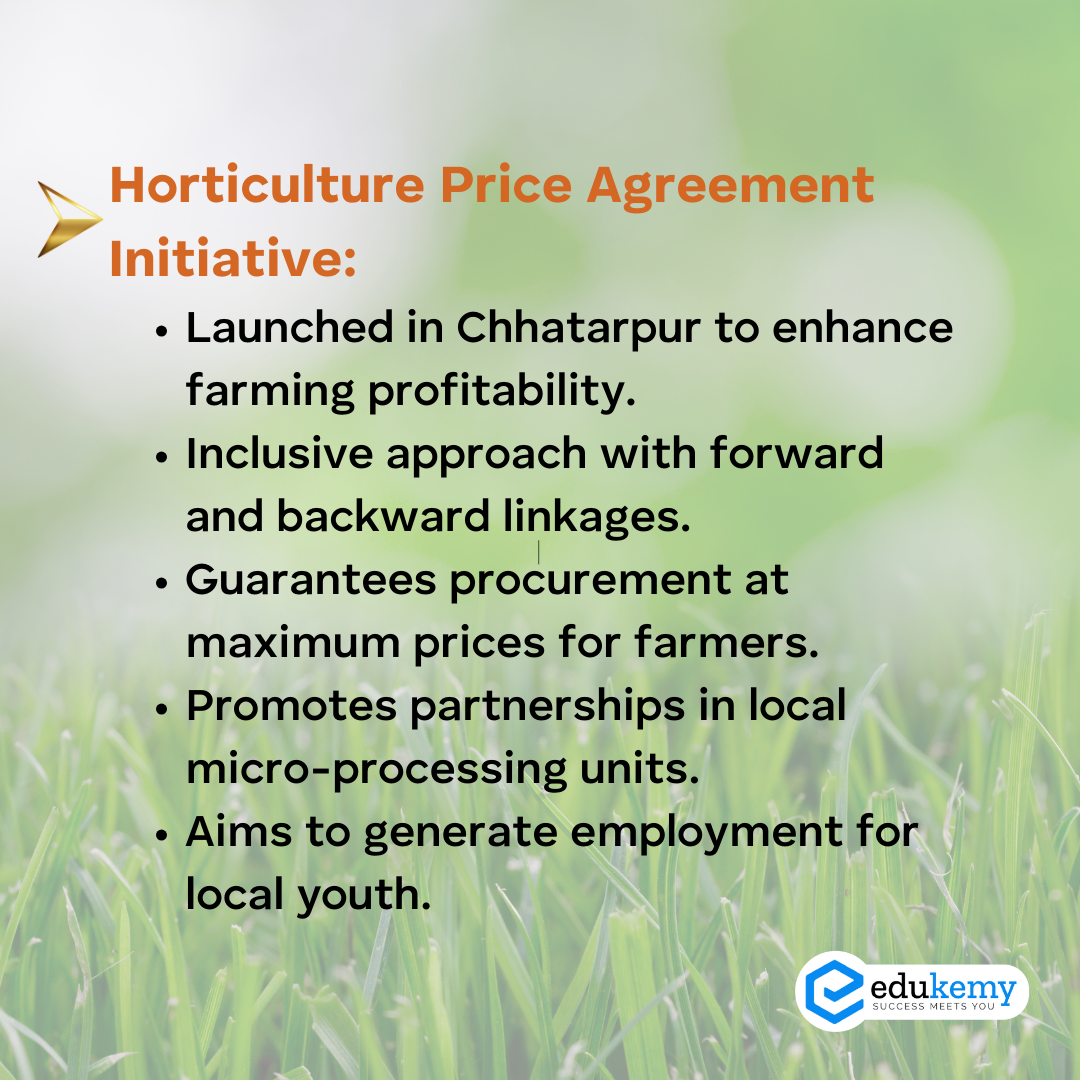
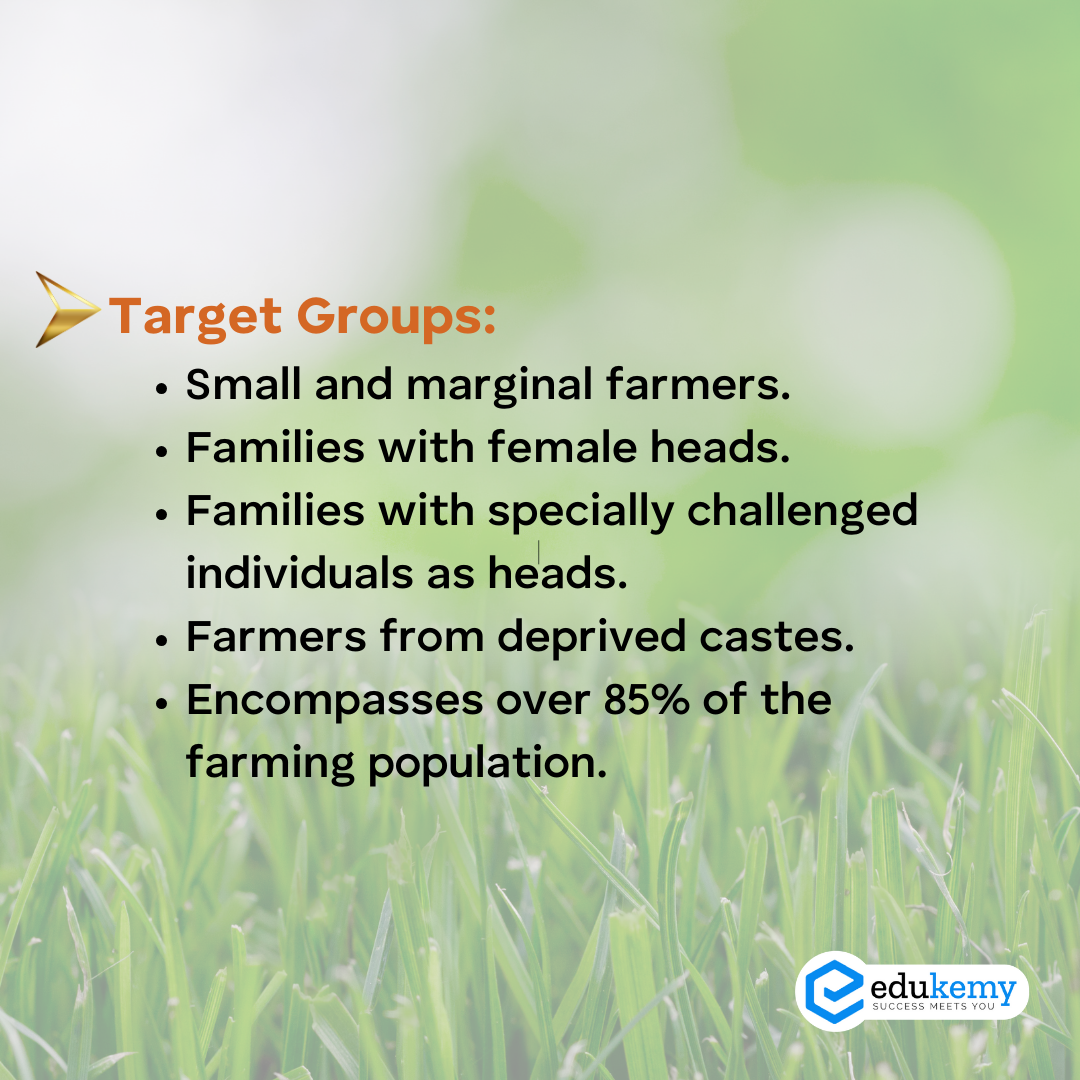

Practice Questions - Current Affairs 24-02-2024
Q1.Consider the following statements regarding Kisan Credit Card scheme
- Short-term credit support is given to farmers for working capital for maintenance of farm assets
- Short-term credit support is given to farmers for purchase of combine harvesters, tractors and mini trucks
- Short-term credit support is given to farmers for consumption requirements of farm households
How many of the statements given above are correct?
- Only one
- Only two
- All three
- None
Q2.Consider the following statements regarding Atmospheric River
- An atmospheric river is a lengthy and narrow band of moisture-laden air, transporting substantial water vapor from the tropics to higher latitudes.
- The phenomena of atmospheric rivers is confined to the US West Coast bringing in copious rainfall.
Which of the statements given above is/are correct?
- 1 only
- 2 only
- Both 1 and 2
- Neither 1 nor 2
Q3. Consider the following statements regarding Particularly Vulnerable Tribal Groups (PVTGs) in India
- PVTGs reside in 18 States and one Union Territory
- A stagnant or declining population is one of the criteria for determining PVTG status
- There are 95 PVTGs officially notified in the country so far
How many of the statements given above are correct?
- Only one
- Only two
- All three
- None
Q4. With reference to Nazool Land consider the following statements
- Nazool land is government-owned land and is administered as state property.
- Emerged during British rule, post-battles with opposing kings who lost their lands
Which of the statements given above is/are not correct?
- 1 only
- 2 only
- Both 1 and 2
- Neither 1 nor 2
Q5. Consider the following statements regarding Bonds and Bond Yield
- A bond is a fixed-income instrument signifying a loan from an investor to a borrower
- Bond yield represents the annual return anticipated by an investor until maturity
- There is an inverse relationship between bond price and yield. When bond prices rise, yields fall, and vice versa
How many of the statements given above are correct?
- Only one
- Only two
- All three
- None
Q6. Consider the following statements regarding National Green Tribunal (NGT) and Central Pollution Control Board (CPCB)
- The NGT has been established by an Act whereas the CPCB has been created by an executive order of the Government
- The NGT provides environmental justice and helps reduce the burden of litigation in the higher courts whereas the CPCB promotes cleanliness of streams and wells, and aims to improve the quality of air in the country
Which of the statements given above is/are correct?
- 1 only
- 2 only
- Both 1 and 2
- Neither 1 nor 2
Q7. Consider the following statements regarding Brumation
- Brumation, unlike hibernation in mammals, is a state of hyper activity observed in reptiles
- The purpose of brumation in reptiles is to conserve energy and endure harsh conditions during periods of dropping temperatures and scarce food resources
- Some snakes and lizards have been observed entering brumation and it is widely not seen in other reptiles unlike hibernaton.
How many of the statements given above are correct?
- Only one
- Only two
- All three
- None
Q8. Consider the following statements regarding Bubonic Plague
- Bubonic Plague is an infectious disease caused by the virus Yersinia pestis, typically found in small mammals and their fleas
- The case-fatality ratio for bubonic plague is 30% to 60%, and pneumonic plague is always fatal when untreated
Select the correct answer using code given below:
- Both Statement-I and Statement-II are correct and Statement-II is the correct explanation for Statement-I
- Both Statement-I and Statement-II are correct and Statement-II is not the correct explanation for Statement-I
- Statement-I is correct but Statement-II is incorrect
- Statement-I is incorrect but Statement-II is correct
Q9. Consider the following statements regarding micro-irrigation
- Fertilizer/nutrient loss can be reduced.
- It is the only means of irrigation in dry land farming.
- In some areas of farming, receding of ground water table can be checked.
How many of the statements given above are correct?
- Only one
- Only two
- All three
- None
Q10. Consider the following statements regarding Conservation of Migratory Species of Wild Animals
- The Convention on the Conservation of Migratory Species, also known as the Bonn Convention, is an environmental treaty under the UNEP
- This convention is the sole global and UN-based intergovernmental organization dedicated exclusively to the conservation and management of terrestrial, aquatic, and avian migratory species.
- Appendix I lists species with an unfavorable conservation status and encourages range states to develop range-wide agreements for the conservation and management of these species
How many of the statements given above are correct?
- Only one
- Only two
- All three
- None
Q11.Consider the following statements regarding Bharat Ratna and Padma Awards
- Bharat Ratna and Padma Awards are titles under the Article 18(1) of the Constitution of India
- Padma Awards, which were instituted in the year 1954, were suspended only once
- The number of Bharat Ratna Awards is restricted to a maximum of five in a particular year
How many of the statements given above are correct?
- Only one
- Only two
- All three
- None
Q12. Consider the following statements regarding Pallava Dynasty
- The Pallava Dynasty held prominence in South India from the 3rd to the 9th centuries.
- The Pallavas were patrons of Buddhism, Jainism, and the Brahminical faith.
- The Pallavas embraced Shaivism.
How many of the statements given above are correct?
- Only one
- Only two
- All three
- None
Q13. With reference to Baltic Sea consider the following statements
- Separates the Scandinavian Peninsula from the rest of continental Asia.
- Regarded as the world’s largest brackish inland water body.
Which of the statements given above is/are not correct?
- 1 only
- 2 only
- Both 1 and 2
- Neither 1 nor 2
Q14. Consider the following statements regarding Energy Sector of India
- India targets 500 GW of non-fossil energy, including 450 GW of renewable energy by 2045
- India aims for net zero emissions by 2070.
Select the correct answer using code given below:
- Both Statement-I and Statement-II are correct and Statement-II is the correct explanation for Statement-I
- Both Statement-I and Statement-II are correct and Statement-II is not the correct explanation for Statement-I
- Statement-I is correct but Statement-II is incorrect
- Statement-I is incorrect but Statement-II is correct
Q15.Consider the following statements regarding Agreement at the UNFCCC Meeting in Paris in 2015
- The Agreement was signed by all the member countries of the UN, and it will go into effect in 2017
- The Agreement aims to limit greenhouse gas emissions so that the rise in average global temperature by the end of this century does not exceed 2ºC or even 1.5ºC above pre-industrial levels
- Developed countries acknowledged their historical responsibility in global warming and committed to donate $ 1000 billion a year from 2020 to help developing countries to cope with climate change
How many of the statements given above are correct?
- Only one
- Only two
- All three
- None
Q16. Consider the following statements regarding INSAT-3DS mission
- INSAT-3DS will be launched using the Geosynchronous Satellite Launch Vehicle F14 (GSLV F14)
- It is partially funded by the Ministry of Earth Sciences (MoES), it belongs to the Third Generation Meteorological Satellites in Geostationary Orbit
Which of the statements given above is/are correct?
- 1 only
- 2 only
- Both 1 and 2
- Neither 1 nor 2
Q17. Consider the following statements regarding Bharatiya Bhasha Samiti
- Constituted by the Ministry of Home Affairs, Government of India in 2021, Bharatiya Bhasha Samiti functions as a High Powered Committee for the Promotion of Hindi Language.
- Bharatiya Bhasha Samiti is entrusted to provide guidance to the Ministry on matters related to the revitalization of language teaching, research, and its extension across various institutions in the country
- Shri Lal Bahadur Shastri National Sanskrit University (SLBSNSU), New Delhi, provides secretarial assistance and space for the committee
How many of the statements given above are correct?
- Only one
- Only two
- All three
- None
Q18. With reference to Electoral Bonds consider the following statements
- These can be purchased from the State Bank of India (SBI), and could be donated to registered political parties for encashment within 14 days.
- Removal of donation limits facilitated crony capitalism in the donation ecosystem.
Which of the statements given above is/are not correct?
- 1 only
- 2 only
- Both 1 and 2
- Neither 1 nor 2
Q19.Consider the following statements regarding solar power production in India
- India is the third largest in the world in the manufacture of silicon wafers used in photovoltaic units
- The solar power tariffs are determined by the Solar Energy Corporation of India
Which of the statements given above is/are correct?
- 1 only
- 2 only
- Both 1 and 2
- Neither 1 nor 2
Q20. Consider the following statements regarding Jute Industry
- Jute is also known as the 'golden fibre’.
- Top export markets include the USA, France, Ghana, the UK.
- Jute Industry is the one of the most undisputed industry in the world with little challenge from the synthetic fibre due to durability of the jute.
How many of the statements given above are correct?
- Only one
- Only two
- All three
- None
Share the article
Edukemy’s Current Affairs Quiz is published with multiple choice questions for UPSC exams
MCQ
Get Latest Updates on Offers, Event dates, and free Mentorship sessions.

Get in touch with our Expert Academic Counsellors 👋
Frequently Asked Questions
UPSC Daily Current Affairs focuses on learning current events on a daily basis. An aspirant needs to study regular and updated information about current events, news, and relevant topics that are important for UPSC aspirants. It covers national and international affairs, government policies, socio-economic issues, science and technology advancements, and more.
UPSC Daily Current Affairs provides aspirants with a concise and comprehensive overview of the latest happenings and developments across various fields. It helps aspirants stay updated with current affairs and provides them with valuable insights and analysis, which are essential for answering questions in the UPSC examinations. It enhances their knowledge, analytical skills, and ability to connect current affairs with the UPSC syllabus.
UPSC Daily Current Affairs covers a wide range of topics, including politics, economics, science and technology, environment, social issues, governance, international relations, and more. It offers news summaries, in-depth analyses, editorials, opinion pieces, and relevant study materials. It also provides practice questions and quizzes to help aspirants test their understanding of current affairs.
Edukemy's UPSC Daily Current Affairs can be accessed through:
- UPSC Daily Current Affairs can be accessed through Current Affairs tab at the top of the Main Page of Edukemy.
- Edukemy Mobile app: The Daily Current Affairs can also be access through Edukemy Mobile App.
- Social media: Follow Edukemy’s official social media accounts or pages that provide UPSC Daily Current Affairs updates, including Facebook, Twitter, or Telegram channels.


